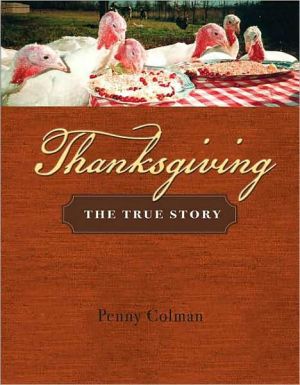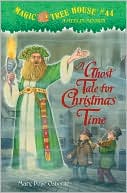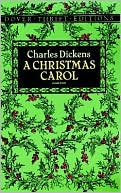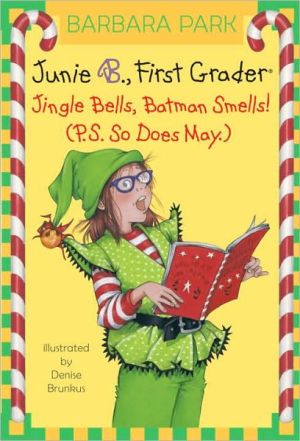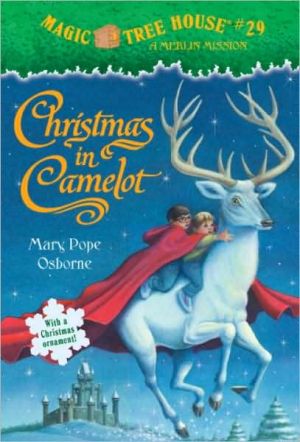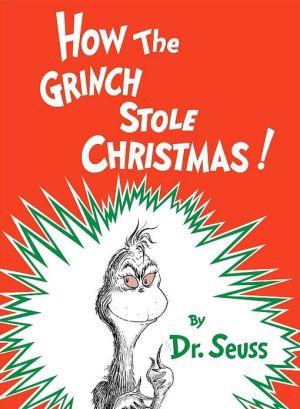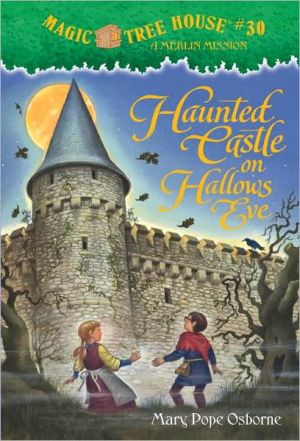Thanksgiving: The True Story
Every year on the fourth Thursday of November, Americans celebrate with a Thanksgiving meal. But what is the origin of this tradition? Did it really begin when the Pilgrims and Native Americans got together in 1621 in Plymouth,Massachusetts?\ In her signature narrative nonfiction style, Penny Colman paints a fascinating picture of this cherished American holiday. She examines numerous Thanksgiving claims which were antecedents to the national holiday we celebrate today, raises the turkey...
Search in google:
Describes the history and activities of the American holiday of Thanksgiving Day.Examines numerous competing claims for the first Thanksgiving, including the traditional story of the feast shared by the Pilgrims and Native Americans in 1621 in Plymouth, Massachusetts. Paints a fascinating picture of the holiday and its changing meanings throughout American history.VOYAThe inspiration for this book emerged from a class Colman taught in which she discovered different claims to the origins of her favorite holiday. Historically there are twelve competing claims for the first Thanksgiving celebration. Colman relates the significance of each claim, debating the educational view of Thanksgiving as the "Pilgrim and Indian" story. Colman also explains the role of Sarah Joespha Hale in the establishment of a national Thanksgiving holiday in November. She looks into the holiday's idealism and traditions, the cooking and chores, charity, football, parades, and games throughout American history. Looking at the evolution of the holiday can help determine the historical ties to its creation. This resource takes the idealism surrounding Thanksgiving into account while trying to discover its origin. Colman created a survey to determine people's knowledge, thoughts, and traditions based on Thanksgiving and then uses historical evidence to understand the shift in perception. The clean layout makes it easy to read, and the abundance of pictures allows the readers to follow the historical changes of the holiday. Colman blends factual evidence with the results from the surveys in each chapter leaving the reader to determine the truth. Reviewer: Jennifer Rummel
Sarah Josepha Hale’s Campaign\ In 1837, Sarah Josepha Hale became the editor of what would become Godey’s Lady’s Book. Under her guidance, Godey’s Lady’s Book grew to have a circulation of 150, 000 readers, an astonishing number at that time. She used the pages of the magazine to advocate for her “suggestion” that: “THE LAST THURSDAY IN NOVEMBER shall be the DAY OF NATIONAL THANKSGIVING for the American people.” (She carefully called her proposal a “suggestion,” so as to not seem unladylike.)\ She selected the last Thursday in November for several reasons: “Because then the agricultural labors of the year are generally completed; the elections are over; those autumnal diseases which usually prevail more or less at the South have ceased, and the summer wanderers are gathered to their homes.” (July 1859) “Thursday,” Hale wrote, “is the most convenient day of the week for a domestic holiday.” She also pointed out that George Washington selected a Thursday in his Thanksgiving Proclamaion.\ Year after year, Sarah Josepha Hale persisted in the “habit of urging on the attention of our readers and friends, . . .the plan of a National Thanksgiving.” Every year, she wrote a special editorial on the subject. She wrote thousands of letters to governors of states and territories and military commanders and ambassadors and five different presidents. She called upon the rest of the press to join in supporting her “suggestion.”\ Much to Offer\ Why was Sarah Josepha Hale so passionate about Thanksgiving? Undoubtedly she was influenced by growing up in New England where an annual autumn Thanksgiving Day was already well established. For her it was a special time for families to gather together to attend church and share a feast. She was also responding to the dramatic transformation of the United States.\ Between 1790-1850 new modes of transportation were developed: Steamboat and canal, then railroads were built. New inventions appeared. Mills and factories were built. Large cities grew: Between 1790-1850, New York City’s population grew from 33,000 to 515, 000. People were on the move and families were spreading apart. Between 1790-1820, 800,000 people left New England and settled in Michigan, Iowa, Wisconsin, Indiana, and Illinois. Hale herself moved from New England to Philadelphia, Pennsylvania. Her son William spent years in Galveston, Texas. In the 1840s, a mass of new immigrants poured into the country. Then there was the issue of slavery that was becoming increasingly contentious and divisive.\ In such tumultuous times, Hale believed that a national Thanksgiving Day had much to offer America. Her vision was of all Americans “uniting as one Great Family Republic.” (11/67) She believed that celebrating a national Thanksgiving Day would “awaken in American hearts the love of home and country, of thankfulness to God, and peace between brethren.” For Hale, Thanksgiving “is a holiday especially worthy of our people. All its associations and all its influences are of the best kind. It reunites families and friends. It awakens kindly and generous sentiments. It promotes peace and good-will among our mixed population. It gives a festival for the homes of all, and to the homeless it brings one day in the year of gladness and plenty. If only for the charitable feeling which it rouses towards the poor, the suffering, and the helpless, the day has a value beyond all expression.”\ In one of her editorials, Hale pointed out that Americans had only two national holidays to celebrate: Washington’s Birthday in February and the Fourth of July. “These are patriotic and political,” she wrote. “Are not the sounds of war borne on the breezes of those festivals? One comes in the cold of winter; the other in the heat of summer; while the glorious autumn of the year, when blessings are gathered in, has no day of remembrance for her gifts of peace. Should not the women of America have one festival in whose rejoicings they can fully participate?”\ Americans Celebrate\ Hale kept track of where and when Americans celebrated a national Thanksgiving Day. Her list included states and territories, American ships in various ports, and American missionaries and students and diplomats in foreign countries.\ “Last year,” she wrote in her 1852 editorial, “twenty nine States, and all the Territorities, united in the festival. This year, we trust that Virginia and Vermont will come into this arrangement . . . .Henceforth wherever an American is found, the last Thursday in November would be the Thanksgiving Day . . . .[and] every heart would on one day in each year, beat in unison of enjoyment and thankfulness.” In a later editorial, she noted that Thanksgiving dinners were held in “London, Paris, Liverpool, Frankfort, Berlin, Florence, and Rome . . . .in Japan at the mouth of the Amoor River, in St. Petersburg and in Rio de Janeiro.”\ Many of these celebrations were initiated by transplanted New Englanders and other settlers who cherished the holiday.\ The governor of Oregon territory succumbed to the pressure of seventy-six Oregon City women. “Be it know that in conformity with the wishes of many citizens of Oregon,” he wrote, “I appoint and set apart Thursday, the 29th of December, 1859, as a day to be kept for PUBLIC THANKSGIVING.” (applebaum 122) The governor of Minnesota territory appeared to need a hint from someone, according to an account by Mrs. Isaac Atwater: “November passed and week by week New Englanders looked for the announcement of their ancient and beloved festival, but even the sacred last Thursday went by without it, and dismay and homesickness filled all hearts. Our good governor must have been of Scotch or Dutch pedigree to have overlooked a duty of such importance; but at last a hint was given him, a brief proclamation was forthcoming, and the day duly celebrated.”\ A transplanted New Englander who lived in Louisiana observed the first Thanksgiving there on January 15, 1846. “Thanks to His excellency Governor Mouton!” the New Englander wrote to relatives in Indiana, “He has seen the evil of his ways, and has at length repented and announced that this year and ever after the people of Louisiana must celebrate a day of Thanksgiving. . . . We are going to try to have a real Yankee dinner, pumpkin pies and everything to match.”\ The Opposition\ Ironically, the idea that Thanksgiving was a New England tradition was one of the reasons people who were not native New Englanders were slow in adopting it. By the late 1880s, however, a widely read newspaper reported: “Each year Thanksgiving becomes more and more a national and less a New-England holiday.” Other people felt that a thanksgiving day should only be proclaimed for special events. Then there were people who resisted the idea of a national Thanksgiving: They thought it should be up to each state to decide the if and when of having an annual Thanksgiving Day. But these sentiments had little effect on the growing numbers of people who heeded Sarah Josepha Hale’s “suggestion” and gathered together to celebrate Thanksgiving Day on the last Thursday in November. In the mid-1840s, Frederika Bremer, a Swedish writer, traveled throughout America. “In America,” Bremer wrote, “there is annually celebrated what is called the Thanksgiving Festival. It occurs in the autumn when the harvest is finished. The families then assemble to rejoice together, and to distribute the earth’s best wealth amid praises of the giver.”\ Sarah Josepha Hale and Abraham Lincoln\ During the first two years of Civil War, the leaders of the Union and Confederacy — Abraham Lincoln and Jefferson Davis—declared special days of thanksgiving for military victories. Lincoln declared one on August 6, 1863, to mark the Union victories, including the Battle of Gettysburg. About that time, Sarah Josepha Hale may have met with Lincoln. Although there is no record of their meeting, Hale’s grandson remembered his father saying that “his mother had visited President Lincoln and had found him a very kindly and interested gentleman.”\ On September 28, 1863, Sarah Josepha Hale wrote to President Lincoln. The purpose of her letter was to “Entreat President Lincoln to put forth his Proclamation, appointing the last Thursday in November . . . as the National Thanksgiving . . . . Thus by the noble example and action of the President of the United States, the permanency and unity of our Great American Festival of Thanksgiving would be forever secured.” She enclosed copies of three of her editorials with her letter.\ A few days later, on October 3, 1863, President Lincoln issued a Proclamation of Thanksgiving for the last Thursday of November. He called upon “my fellow citizens in every part of the United States, and also those who are at sea and those who are sojourning in foreign lands, to set apart and observe . . . a day of Thanksgiving and Praise.”\ Lincoln’s proclamation was in the tradition of an annual, general Thanksgiving Day. Sarah Josepha Hale had realized her goal, part of it at least. For she knew that a presidential proclamation only applied to federal employees and residents of the District of Columbia. As for the rest of the country, a president could only recommend that governors proclaim Thanksgiving Day. It would take an act of Congress to have a National Thanksgiving become an official holiday, thus ‘forever secured,” and not dependent on the whim of future presidents and governors.\ Final Appeal\ Now, Sarah Josepha Hale focused her efforts on getting Congress to pass legislation making Thanksgiving the “third American holiday.” She continued her efforts until 1877, when she retired at the age of eighty-nine. She died two years later, at the age of ninety-one.\ “This is probably the last occasion upon which the Editress of the Lady’s Book will speak to the public through the pages of this magazine, on a subject which has been near to her heart for many years,” she wrote in her last editorial. “Let the Fifty-fifty Congress, in the name of the American people, enact that from henceforward the last Thursday in November shall be observed, throughout the length and breadth of our land, as the day of our National Thanksgiving.”\ Sixty-four years would pass before Congress established Thanksgiving as an official holiday. Nevertheless the tradition of an annual national Thanksgiving Day was firmly established. For that Sarah Josepha Hale was largely responsible. Perhaps, as some people have already claimed, she was the mother of our Thanksgiving.\ Sixty-four Years Later\ Congress finally made Thanksgiving Day a legal holiday in 1941 in response to the conflict that erupted over the issue of which Thursday to celebrate.\ The conflict over the different Thursdays had erupted in 1939, a year in which November has five Thursdays. Hoping that more shopping days would mean more sales, a national association of merchants asked President Franklin Delano Roosevelt (FDR) to change Thanksgiving from the last Thursday, the traditional day, to the fourth Thursday. They had made the same request in 1933, another year with five Thursday, but FDR refused. This time he agreed and made the announcement in August.\ It is unlikely that FDR anticipated the controversy that erupted, but it did. Telegrams and letters poured into the White House. How dare he change the “hallowed traditional” date! What would happen to all the traditional Thanksgiving Day football games? What about school vacations days that were already set? “I am afraid your change for Thanksgiving,” wrote the owner of a calendar company, “is going to cause the calendar manufacturers untold grief.” Politicians, ministers, newspaper editors and cartoonists expressed their opinions on both sides. Some people kept a sense of humor, including Shelby O. Bennett of Shinnston, West Virginia, who wrote the following letter:\ Mr. President:\ I see by the paper this morning where you want to change Thanksgiving Day to November 23 of which I heartily approve. Thanks.\ Now, there are some things that I would like done and would appreciate your approval.\ 1. Have Sunday changed to Wednesday:\ 2. Have Monday’s to be Christmas;\ 3. Have it strictly against the Will of God to work on Tuesday;\ 4. Have Thursday to be Pay Day with time and one-half for overtime;\ 5. Require everyone to take Friday and Saturday off for a fishing trip down the Potomac.\ With these in view and hoping you will give me some consideration at your next Congress.\ Twenty-one states changed the date. Sixteen states refused. Thus, 1939 became known as the year of two Thanksgivings, as was the following year.\ All that uproar and confusion, prompted Congress to finally make Thanksgiving a legal holiday and to set a fixed date. The House of Representatives passed a resolution declaring the last Thursday in November to be the legal Thanksgiving Day. The Senate, amended that resolution to set the date as the fourth Thursday, in order to accommodate the years when November has five Thursdays. The House agreed, thus ending the confusion and established Thanksgiving as a national holiday.\ The True Story\ As you can see, the origins of the Thanksgiving that we celebrate today cannot be directly traced to the inspiration of a single historical event, such as the 1621 “Pilgrim and Indian” feast. Its origins are much more complicated. The true story involves multiple influences—two very old traditions and the activism of a determined woman—that were finally officially recognized by an act of Congress.\ But what about the “Pilgrim and Indian” story that we all know so well?
\ Children's Literature - Elizabeth Young\ Very rarely do we find books written about a holiday for readers too old for picture books, yet not quite ready for imposing tomes. This work is a welcome exception, and one that could easily find its way into a school curriculum. Colman has studied the Thanksgiving holiday, trying to present the true reason for the occasion. The Thanksgiving we celebrate today on the fourth Thursday in November has only been a national observance since 1941. Prior to that, it was celebrated on other dates, and at the discretion of the President of the United States or state governor. Other events, such as a thanksgiving celebration in the Texas panhandle in 1541, a celebration for French settlers in Florida in 1564, and a feast with settlers and Abenaki Indians in Maine in 1607, all have a place documenting a separate day of thanks. The traditional Thanksgiving we know began as a glimmer of hope for a magazine editor wishing the entire nation would stop and enjoy a day of reflection and thankfulness. Sarah Josepha Hale is primarily responsible for the holiday and its inclusion in American history, though it was not an easy effort. Her story is told here and is well documented. What about the pilgrim and Indian version of the story? Is that true? It could be, though it is probably not likely. Colman has done her research and presented how schools have perpetuated this story and many believe it as truth. A good classroom discussion is likely after reading this book, reflecting on the students' beliefs, traditions, what they like most—or least—about the holiday, their perceptions of how it originated, as this book lends itself to follow-up sessions. Colman's writing style is much different thantextbooks and other works of nonfiction. Her narrative style is reminiscent of a college master's thesis and, at times, defeats the authenticity of her message. Following the text are ample notes and a handy chronology of events leading to the modern Thanksgiving: shopping, football, and all. Reviewer: Elizabeth Young\ \ \ \ \ VOYA - Jennifer Rummel\ The inspiration for this book emerged from a class Colman taught in which she discovered different claims to the origins of her favorite holiday. Historically there are twelve competing claims for the first Thanksgiving celebration. Colman relates the significance of each claim, debating the educational view of Thanksgiving as the "Pilgrim and Indian" story. Colman also explains the role of Sarah Joespha Hale in the establishment of a national Thanksgiving holiday in November. She looks into the holiday's idealism and traditions, the cooking and chores, charity, football, parades, and games throughout American history. Looking at the evolution of the holiday can help determine the historical ties to its creation. This resource takes the idealism surrounding Thanksgiving into account while trying to discover its origin. Colman created a survey to determine people's knowledge, thoughts, and traditions based on Thanksgiving and then uses historical evidence to understand the shift in perception. The clean layout makes it easy to read, and the abundance of pictures allows the readers to follow the historical changes of the holiday. Colman blends factual evidence with the results from the surveys in each chapter leaving the reader to determine the truth. Reviewer: Jennifer Rummel\ \ \ VOYAAlthough the history of the first Thanksgiving in America is uncertain, Colman spends the first two chapters discussing the various claims to the first occurance and the traditions of harvest festivals and declarations of thanksgiving days. Included are Sarah Josepha Hale's letters to United States presidents requesting an official national holiday of Thanksgiving and a chapter devoted to the popular Pilgrim and Indian story. Colman mentions little-known facts about Thanksgiving as well - the ragamuffins who begged for fruit in the streets of New York City and the Fantastical parade of wild, costumed men that occurred in the late 1700s and 1800s. Colman writes this nonfiction book in first person, similar to her bestseller Corpses, Coffins and Crypts: A History of Burial (Henry Holt, 1997). Her own personal comments about how Thanksgiving is celebrated in her home and details about her research process makes the book friendly to the reader. The book reads easily and quickly, and the illustrations and photographs of Thanksgivings of the past are fascinating. The appendix provides a chronology, detailed notes, and sources that include many primary sources and Web sites. Pair this with the picture book Thank You, Sarah: the Woman Who Saved Thanksgiving by Laurie Halse Anderson (Aladdin/S & S, 1997) during Thanksgiving week to encourage discussion of Thanksgiving traditions and history revision. Reviewer: Sarah Hill\ \ \ \ \ School Library JournalGr 5-9\ In an effort to discover the real story of Thanksgiving, or rather the true first Thanksgiving, Colman conducted research that included firsthand accounts, proclamations, magazine and newspaper articles, museum exhibits, and interviews. The first section of the book discusses the history of the holiday and its various observations; the second half describes the traditions that have evolved around it. The writing is clear and readable, and a number of the black-and-white photos and reproductions enliven the text. This title is similar to Laurie Hillstrom's The Thanksgiving Book (Omnigraphics, 2007), which contains even more primary sources. Colman's title should be considered as an additional purchase where there is a strong need for books about the holiday.-Geneva Reeder, Lower Dauphin Middle School, Hummelstown, PA\ \ \ \ \ \ Kirkus ReviewsAfter surveying "competing claims" for the first Thanksgiving from 1541 on, in Texas, Florida, Maine, Virginia and Massachusetts, Colman decides in favor of the 1621 event with the English colonists and Wampanoag as the first "because the 1621 event was more like the Thanksgiving that we celebrate today." She demonstrates, however, that the "Pilgrim and Indian" story is really not the antecedent of Thanksgiving as we celebrate it today. Rather, two very old traditions-harvest festivals and days of thanksgiving for special events-were the origin, and this interesting volume traces how the custom of proclaiming a general day of thanksgiving took hold. Yet, since many Thanksgiving celebrations in towns and schools are still rooted in the "Pilgrim and Indian" story, which the author calls "true and important," but which many Native Americans find objectionable, a more in-depth discussion of it is warranted here. The solid bibliography does include some fine resources, such as 1621: A New Look at Thanksgiving (2001) by Catherine O'Neill Grace and Margaret M. Bruchac. (author's note, chronology, index) (Nonfiction. 8-12)\ \
